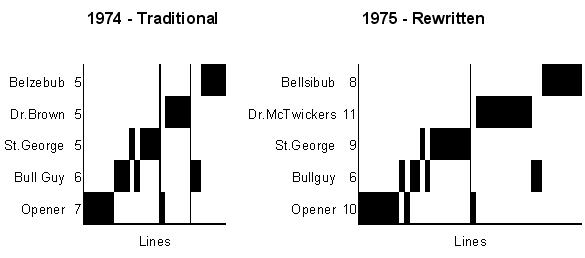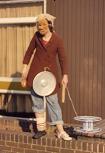"This is a Mummers’ play I wrote": Part 6 - Performers' Rewrites
Performers' RewritesThe Jacksdale Brut King play described under Previous Work is an example of a performers' rewrite. These are plays written by a performing group to supplement or replace their existing play or repertoire. This may apply to both traditional and folk revival groups, although clearly the implications are more significant for traditional groups. Either way, the groups normally retain their existing performance pattern. In the case of traditional teams, this means that they stick to their traditional performing season and itinerary. Similarly, revival teams will keep to their usual venues, for example folk clubs and pubs. The rewritten play may be performed during several seasons or sessions rather than just once. At Jacksdale, the declared purpose of the rewrite was to bring the play up to date in order to appeal more to modern audiences. Another reason may be to accommodate new needs, for instance the need for a longer play, or to include more actors. The scripts tend mostly to be newly composed, although some traditional characters and speeches are often retained for authenticity or to match audience expectations. They may incorporate material from the popular mass media and include topical allusions. The scripts therefore can have some similarity to mumming skits. The Meevagh Mummers of Carrigart, Donegal are another example (Críostóir Mac Cáirthaigh, 2002). This play was rewritten to feature key figures from the period of the Second World War - Herr Hitler, Mussolini, Churchill, Goebbels, President Roosevelt, Stalin, Gandhi and De Valera. The play was first conceived in 1941 by John M.McGettigan of Glenree and performed for perhaps two seasons. It was later revived in 2000 to raise funds for charity. The two protagonists are Herr Hitler and Churchill, with Hitler losing the fight. It is Doctor Goebbels who is brought on to cure Hitler. The rest of the play is a procession of the remaining world figures whose speeches include comments on various aspects of the war. |
 Fig.6 - Eastwood Guysers' Plays: Graphs representing the structures of the texts |
|
|
The graphs in Fig.6 were prepared using method I first described in Roomer in 1980 (P.Millington, 1980). Each graph is basically a grid, where the horizontal axis indicates the lines of the play, thus representing its duration. The vertical axis shows the characters in order of appearance working from the bottom up. Rectangles in the grid are shaded according which character is speaking a given line. Vertical rules drawn within the grid indicate the positions of stage directions. The numbers next to the character names give the total number of lines spoken by each character. Both graphs conform to one of the common patterns I have observed for folk plays of whatever subject or language. The main features of this pattern are: |
|
The structures of the two Eastwood versions are effectively identical. Bullguy has a brief additional dialogue with the Opener, but otherwise the most obvious difference is that the rewritten version is nearly 60% longer than the traditional version. The character names are also essentially the same, although the doctor has been renamed Dr.McTwickers in order not to rhyme with the word "knickers" - a piece of deceptive risqué humour. |
|
